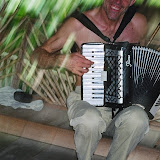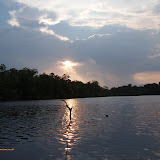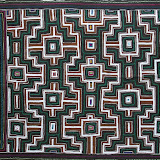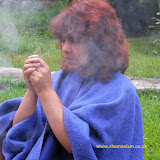 The Western rational mind can only struggle, to take as an example the famed ‘love potion’ of the Amazon known as the Pusanga. In rational terms it makes no sense whatsoever, how can a concoction of leaves, roots, and seeds attract a lover, or good luck to you?
The Western rational mind can only struggle, to take as an example the famed ‘love potion’ of the Amazon known as the Pusanga. In rational terms it makes no sense whatsoever, how can a concoction of leaves, roots, and seeds attract a lover, or good luck to you? My experience working with shamans in preparing Pusangas (which normally is prepared away from their clients so it was a privilege to be invited to participate in the preparation) showed me that far from interfering with the freedom of other individuals or putting a ‘number’ on them, we were altering something within ourselves, which was brought out by the ingredients, the magic of the plants. Whatever it was, it felt wholesome and good. It is what is in oneself… one’s own magic. Asking Javier Arevalo (the shaman) what does the Pusanga actually do, is it inside us or outside of us? His response was “When you pour it onto your skin it begins to penetrate your spirit, and the spirit is what gives you the force to pull the people. The spirit is what pulls”.
The anthropological term ‘sympathetic magic’ does not give this justice, to illustrate this, the water used in the preparation of an authentic pusanga (which has been specifically made for you) has been collected from a deep trek in the rainforest, sometimes 40 or 50 miles, where there are no people and where clay pools collect and thousands of the most beautiful coloured parrots and macaws gather to drink from them for the mineral content. Now the great leap of imagination required is to bring into yourself the knowledge, the feeling, the sense that the water in the Pusanga has drawn in or attracted thousands of the most brightly coloured creatures on the planet. If you do this, it can generate a shift in consciousness in you.
You can sample this for yourself, just find a quiet moment and space, close your eyes, and with the power of your imagination as the launch pad, draw in the verdant, abundant forest filled with life, colour, and sound. Sense the rich vibrancy of the rainforest as a single breathing rhythmic totality of life force. When you have this image, expand it to include, the humid warmth, the smell of earth, the scent of plants, hear the sound of insects and bird song, allow all your senses to experience this. Then with a conscious decision draw this sensory experience into your being. Whenever you are ready, open your eyes, and check how you are feeling.
Maestros do not invent diets, they are given by the plant spirits themselves, but there is more to it than simply abstaining from certain foods and activities. It involves a state of purification, retreat, commitment, and respect for our connection with everything around us - above all the rain forest. When we listen to our dreams, they become more real, and equally important as everyday life.
Morality, Ethics and Power
This is a subject that is worth looking at as we in the West and particularly those who are engaged in following a perceived spiritual path in which there is an implicit or explicit ethical component, find the use of a pusanga (or equivalent) to attract a specific person an action which takes away and subverts that person’s free will. This is criticised as an immoral and harmful action occurring within a tradition or system without perceived , never mind understood moral values.
This moral view is not shared in other societies and traditions, and there is a profound difficulty experienced by Westerners in assimilating this concept of values surrounding power.
For example the Amazonian (amongst others) tradition portrays a spectrum of existential states, with the highest or most desirable being that of the powerful person, and the lowest or least desirable being that of the powerless person. Power is defined as the ability to do what one wishes, obtain wealth, make others perform desired actions (even against their will), or harm others without being punished or harmed in return. The proof of power is the individual's material wealth, or social and political status, and their ability to offer patronage. These are not received as immoral acts, and I recall with my colleague Peter Cloudsley attempting to relay the Western view to Javier Arevalo without any success. The conversation went as follows;
Howard & Peter: “Something we make a big problem out of in the West, is that a shaman might be a magician to one person and a sorcerer to another. Asking for the pusanga to attract a specific person takes away that person’s choice. We see it as bad. How do you see it?”
Javier: “Take the case of a woman who refuses when you offer her a Coca Cola because she thinks you are lower class and that she is better than you. She might want others to think that she is better than you. That makes you feel like rubbish so you go to a shaman and tell him the name of the girl. He prepares the pusanga. Three days go by without seeing her and she begins to think about you, dreaming about you and begins looking for you”
Howard & Peter: “Yes, we understand, but in our culture we think its wrong to counteract someone’s will.”
Javier: “But its only so that she will want you for the moment, so she’ll go to bed with you and then she can go”.
Howard & Peter: “(laughing) But if it happened to me, and let’s say I originally found her unpleasant and she did it to marry me I’d be outraged! It would be awful if I only discovered after having children and making a home with her! And would I ever know?”
Javier: “You would be hopelessly in love with her, you’d never know. That’s why it’s a secret.”
Howard & Peter: “Can a jealous third party separate a couple or break a happy marriage?”
Javier: “Yes, they can ruin a happy home. They come as if to greet the couple and soon after the couple are arguing and hating each other and the third party is secretly having sex with one of them”.
Howard & Peter: “Is this why the women from Lima are afraid of the girls from Iquitos?”
Javier: “Yes it happens, they think they are dangerous and will break up their homes.”
Howard & Peter: “Does anyone have freedom if everyone is using pusanga?”
Javier: “its normal you get used to it.”
Howard & Peter. “We like to think we are free, this suggests that we are constantly subject to other peoples’ Pusanga.”
Javier: “laughing, but you all want women, and women all want men!”
Eventually we realised that there was no way that we could communicate this Western ‘moral’ viewpoint. Javier did not see that there was a problem. It was a massive cultural divide we could not cross. His people feel free the way they are and can have extramarital sex using magical means of attraction and without attaching our Western guilt to it.
Looking at this ‘down to earth’, guilt trip free viewpoint, on an earlier occasion when Javier asked the group that I was leading, what they really wanted deep down in their lives, many people gave cosmic, transpersonal, and spiritual sounding answers and were quite mute when he spoke about Pusanga. After a while the participants opened up to their feelings and many admitted they wanted love, apparently behind their desire to put the world to right, resolve planetary issues, and speak to the flowers. It was as though it were not acceptable to wish for love. Javier remarked “These thoughts tangle up their lives. Love solves problems”.
As an observation, if we (and that’s all of us) had more love in our lives, maybe we wouldn’t be worried so much about the state of the world, and be less judgemental, destructive, and just simply be willing to help others and alleviate suffering. It is because people do not have enough of this precious and enriching commodity that we live our lives increasingly bombarded by aggression, with new definitions , ‘road rage’ , ‘air rage’ , ‘safety rage’, ‘word rage’, ‘whatever-you-want rage’ We would also need less material goods, and titles all of which reinforce the boundaries of the ego-mind and separate us from each other and the natural world.
Below is a video of Plants used to prepare Pusanga. The soundtrack is a beautiful Icaro chanted by mestizo shaman Artidoro (recorded on Eagle's Wing Ayahuasca Retreat).
Visit our website for details on our Amazon Ayahuasca & Plant Spirit Shamanism Retreats















 Karen Sawyer, the author of Soul Companions, has posted up a very nice video about her book;
Karen Sawyer, the author of Soul Companions, has posted up a very nice video about her book;















